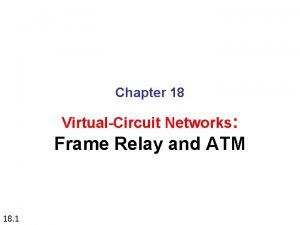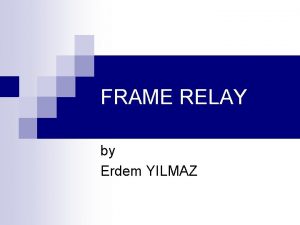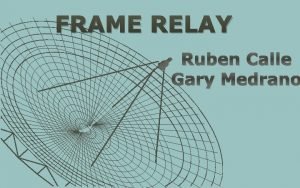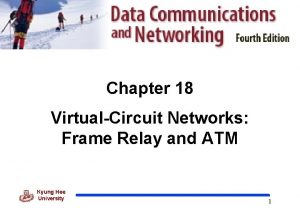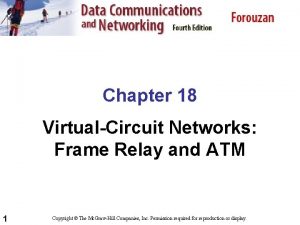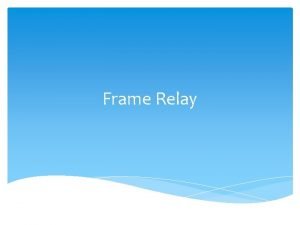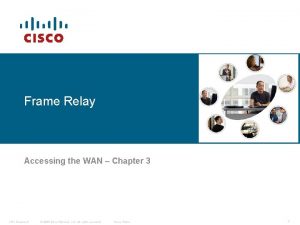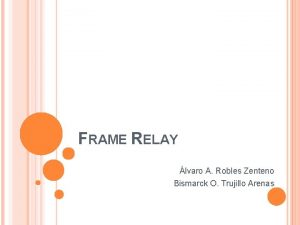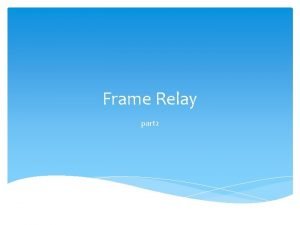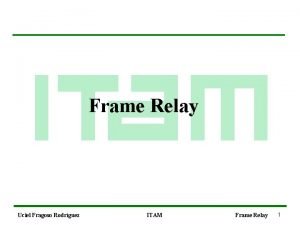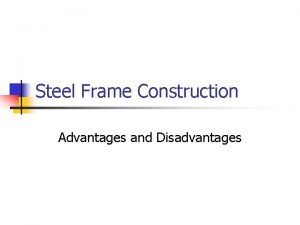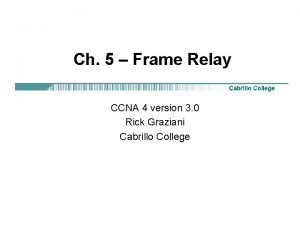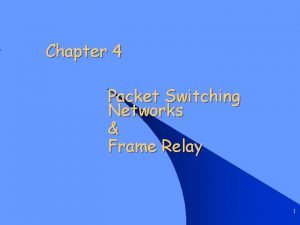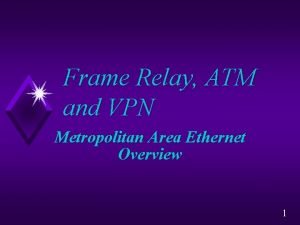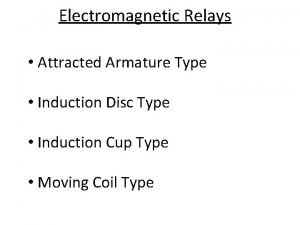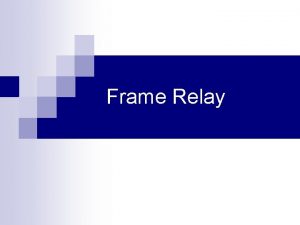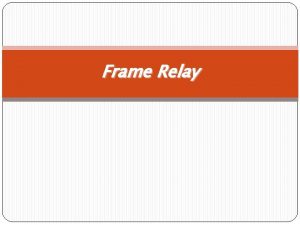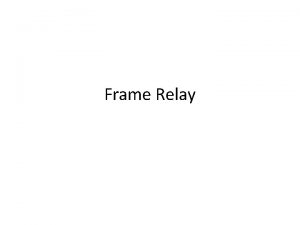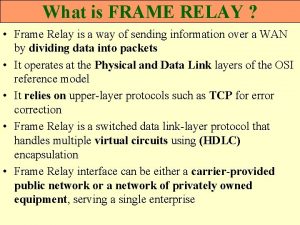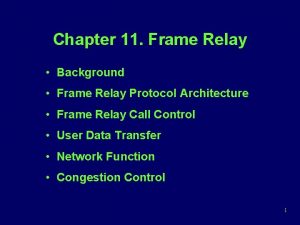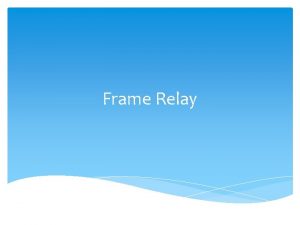Frame Relay n n n Frame Relay has
























- Slides: 24

Frame Relay n n n Frame Relay has become one of the most popular WAN services deployed over the past decade Primary reason is cost Frame Relay technology frequently saves money over alternatives, and very few network designs ignore the cost factor Frame Relay, by default, is classified as a nonbroadcast multi-access (NBMA) network Which means that it does not send any broadcasts, such as RIP updates, across the network by default

Frame Relay n n Frame Relay has at its roots a technology called X. 25 Frame Relay essentially incorporates the components of X. 25 relevant to today’s reliable and relatively “clean” telecommunications networks and leaves out the error-correction components that aren’t needed anymore It’s more complex than the simple leased-line networks such as HDLC and PPP protocols It’s often represented as a “cloud” in networking graphics

Introduction to Frame Relay Technology n n Frame Relay is a packet-switched technology Frame Relay doesn’t work like a point-to-point leased line (although it can be made to look like one

Frame Relay Technology n n n The basic idea behind Frame Relay networks is to allow users to communicate between two DTE devices (in this case, routers) through DCE devices The users shouldn’t see a difference between connecting to and gathering resources from a local server and a server at a remote site connected with Frame Relay other than a potential change in speed Figure illustrates everything that must happen in order for two DTE devices to communicate

Introduction to Frame Relay Technology

Frame Relay Technology n n 1. The user’s network host sends a frame out on the local area network The hardware address of the router (default gateway) will be in the header of the frame 2. The router picks up the frame, extracts the packet, and discards what is left of the frame It then looks at the destination IP address within the packet and checks to see whether it knows how to get to the destination network by looking into the routing table

Frame Relay Technology n n n 3. The router next forwards the data out the interface that it thinks can find the remote network The router puts the packet onto the Frame Relay network encapsulated within a Frame Relay frame 4. The channel service unit/data service unit (CSU/DSU) receives the digital signal and encodes it into the type of digital signaling that the switch at the packet switching exchange (PSE) can understand For example, it may alter it from the encoding used in V. 35 to the encoding of the access line, which might be B 8 ZS over a T 1 The PSE receives the digital signal and extracts the ones and zeros from the line

Frame Relay Technology n n 5. The CSU/DSU is connected to a demarc installed by the service provider, and its location is the service provider’s first point of responsibility (last point on the receiving end) The demarc is typically just an RJ-45 (8 -pin modular) jack installed close to the router and CSU/DSU (sometimes called a Smart Jack) 6. The demarc is typically a twisted-pair cable that connects to the local loop. The local loop connects to the closest central office (CO), sometimes called a point of presence (POP) The local loop can connect using various physical mediums; twisted-pair or fiber is common

Frame Relay Technology n n n n 7. The CO receives the frame and sends it through the Frame Relay “cloud” to its destination This cloud can be dozens of switching offices—or more! 8. Once the frame reaches the switching office closest to the destination office, it’s sent through the local loop The frame is received at the demarc, and is then sent to the CSU/DSU Finally, the router extracts the packet, or datagram, from the frame and puts the packet in a new LAN frame to be delivered to the destination host The frame on the LAN will have the final destination hardware address in the header This was found in the router’s ARP cache, or an ARP broadcast was performed

Frame Relay Technology n n n The user and server do not need to know, everything that happens as the frame makes its way across the Frame Relay network The remote server should be as easy to use as a locally connected resource There are several things that make the Frame Relay circuit different than a leased line With a leased line, you typically specify the bandwidth you desire (T 1, fractional T 1, DS 3, etc. ) But with Frame Relay, you specify both an access rate (port speed) and a CIR

Committed Information Rate (CIR) n n n Frame Relay provides a packet-switched network to many different customers at the same time This is a great idea because it spreads the cost of the switches, etc. , among many customers Frame Relay is based on the assumption that all customers will never need to transmit constant data all at the same time Frame Relay works by providing a portion of dedicated bandwidth to each user, and also allowing the user to exceed their guaranteed bandwidth if resources on the telco network are available Frame Relay providers allow customers to buy a lower amount of bandwidth than what they really use There are two separate bandwidth specifications with Frame Relay:

Committed Information Rate (CIR) n n Access rate The maximum speed at which the Frame Relay interface can transmit CIR The maximum bandwidth of data guaranteed to be delivered n n n However, in reality, this is the average amount that the service provider will allow you to transmit If these two values are the same, the Frame Relay connection is pretty much just like a leased line However, they can also be set to different values

Committed Information Rate (CIR) n n Here’s an example Let’s say that, you buy an access rate of T 1 (1. 544 Mbps) and a CIR of 256 Kbps By doing this, the first 256 Kbps of traffic you send is guaranteed to be delivered Anything beyond that is called a “burst, ” which is a transmission that exceeds your guaranteed 256 Kbps, and can be any amount up to the T 1 access rate (if that amount is in your contract)

Virtual Circuits n n Frame Relay operates using virtual circuits, as opposed to real circuits that leased lines use These virtual circuits are what link together the thousands of devices connected to the provider’s “cloud. ” Frame Relay provides a virtual circuit to be established between your two DTE devices, making them appear to be connected via a circuit when in reality they are dumping their frames into a large, shared infrastructure You never see the complexity of what is happening inside the cloud because you have a virtual circuit

Virtual Circuits n n There are two types of virtual circuits—permanent and switched Permanent Virtual Circuits (PVCs) are by far the most common type in use today n n Permanent means that the telco creates the mappings inside their equipment, and as long as you pay the bill, they will remain in place Switched Virtual Circuits (SVCs) are more like a phone call n The virtual circuit is established when data needs to be transmitted, then is taken down when data transfer is complete

Data Link Connection Identifiers (DLCIs) n n n Frame Relay PVCs are identified to DTE end devices using Data Link Connection Identifiers (DLCIs) A Frame Relay service provider typically assigns DLCI values, which are used on Frame Relay interfaces to distinguish between different virtual circuits Because many virtual circuits can be terminated on one multipoint Frame Relay interface, many DLCIs are often affiliated with it Inverse ARP (IARP) is used with DLCIs in a Frame Relay network It maps a DLCI to an IP address (like ARP does with MAC addresses to IP addresses)

Data Link Connection Identifiers (DLCIs) n n n n When Router. A wants to send a frame to Router. B, it looks up the IARP or manual mapping of the DLCI to the IP address it’s trying to get to Then it sends the frame out with the DLCI value it found in the DLCI field of the FR header The provider’s switch gets this frame and does a lookup on the DLCI/physical-port combination it observes Associated with that combination, it finds a new “locally significant” (between it and the next-hop switch) DLCI to use in the header, and in the same entry in its table, it finds an outgoing physical port This happens all the way to Router. B Therefore, you actually can say that the DLCI that Router. A knows identifies the entire virtual circuit to Router. B, even though every DLCI between every pair of devices could be completely different The point is that Router. A is unaware of these differences That’s what makes the DLCI locally significant

Data Link Connection Identifiers (DLCIs) n n n DLCI 100 is considered locally significant to Router. A and identifies the circuit between Router. A and Frame Relay switch DLCI 200 would identify the circuit between Router. B and its connected Frame Relay switch DLCI numbers, used to identify a PVC, are typically assigned by the provider and start at 16

Local Management Interface (LMI) n n n Local Management Interface (LMI) is a signaling standard used between your router and the first Frame Relay switch it’s connected to It allows for passing information about the operation and status of the virtual circuit between the provider’s network and the DTE (your router) It communicates information about the following: Keepalives These verify that data is flowing Multicasting This is an optional extension of the LMI that allows, for example, the efficient distribution of routing information and ARP requests over a Frame Relay network n Multicasting uses the reserved DLCIs from 1019 through 1022

Local Management Interface (LMI) n n Global addressing This provides global significance to DLCIs, allowing the Frame Relay cloud to work exactly like a LAN Status of virtual circuits This provides DLCI status n n n These status inquiries and status messages are used as keepalives when there is no regular LMI traffic to send LMI is not communication between your routers—it’s communication between router and the nearest Frame Relay switch It’s entirely possible that the router on oneend of a PVC is actively receiving LMI, while the router on the other end of the PVC is not

Local Management Interface (LMI) n n Routers receive LMI information from the service provider’s Frame Relay switch on a frame encapsulated interface and update the virtual circuit status to one of three different states: Active state Everything is up, and routers can exchange information Inactive state The router’s interface is up and working with a connection to the switching office, but the remote router is not working Deleted state No LMI information is being received on the interface from the switch. It could be a mapping problem or a line failure

Frame Relay Congestion Control n n n n Is there any way for us to find out when our telco’s shared infrastructure is free and clear and when it’s not? And if there is, how do we go about it? Here are three congestion bits and their meanings: Discard Eligibility (DE) when you burst (transmit packets beyond the CIR of a PVC), any packets exceeding the CIR are eligible to be discarded if the provider’s network is congested Because of this, the excessive bits are marked with a Discard Eligibility (DE) bit in the Frame Relay header If the provider’s network is congested, the Frame Relay switch will discard the packets with the first DE bit set So if your bandwidth is configured with a CIR of zero, the DE will always be on

Frame Relay Congestion Control n n Forward Explicit Congestion Notification (FECN) When the Frame Relay network recognizes congestion in the cloud, the switch will set the Forward Explicit Congestion Notification (FECN) bit to 1 in a Frame Relay packet header This will indicate to the destination DTE that the path the frame just traversed is congested Backward Explicit Congestion Notification (BECN) When the switch detects congestion in the Frame Relay network, it’ll set the (BECN) bit in a Frame Relay frame that’s destined for the source router This notifies the router that congestion is being encountered ahead

Frame Relay Congestion Control n n Backward Explicit Congestion Notification (BECN) When the switch detects congestion in the Frame Relay network, it’ll set the (BECN) bit in a Frame Relay frame that’s destined for the source router This notifies the router that congestion is being encountered ahead
 Frame relay and atm
Frame relay and atm Frame relay frame format
Frame relay frame format Frame relay frame format
Frame relay frame format Frame relay and x.25
Frame relay and x.25 Frame relay caracteristicas
Frame relay caracteristicas Frame relay vs atm vs mpls
Frame relay vs atm vs mpls Frame relay and atm
Frame relay and atm Frame relay packet tracer
Frame relay packet tracer Frame relay wan
Frame relay wan Frame relay
Frame relay Frame relay lmi
Frame relay lmi Protocolo lapd
Protocolo lapd Frame relay osi
Frame relay osi Transmission mac
Transmission mac Steel frame construction advantages and disadvantages
Steel frame construction advantages and disadvantages Ccna frame relay
Ccna frame relay Participio de frame
Participio de frame Frame relay architecture
Frame relay architecture Frame relay packet switching
Frame relay packet switching Show frame-relay map
Show frame-relay map Frame relay vs vpn
Frame relay vs vpn Shaded pole type relay
Shaded pole type relay Frame by frame animation programs
Frame by frame animation programs Pengertian animasi frame by frame
Pengertian animasi frame by frame Let him who has ears to hear
Let him who has ears to hear
